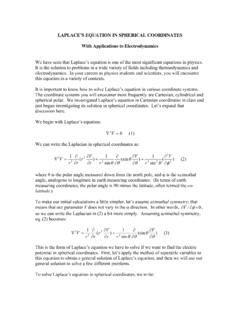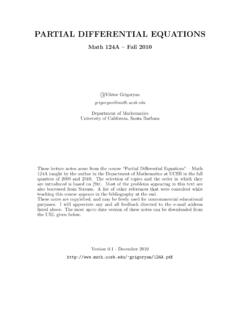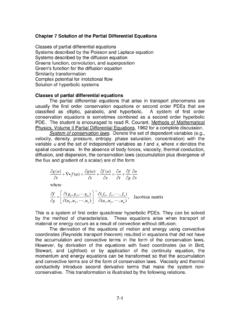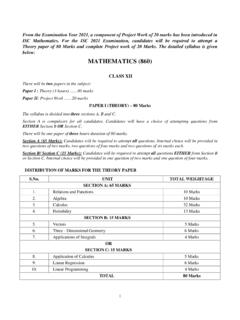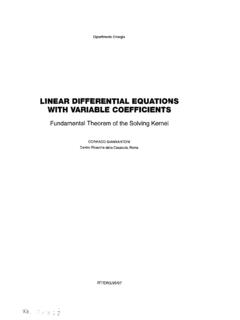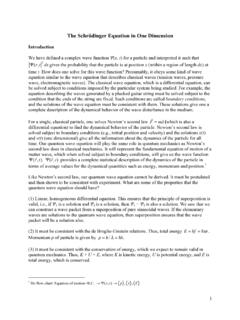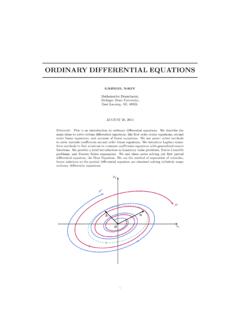Transcription of SERIES SOLUTIONS OF DIFFERENTIAL EQUATIONS
1 SERIES SOLUTIONS OF DIFFERENTIAL EQUATIONS SOME WORKED EXAMPLES First example Let s start with a simple DIFFERENTIAL equation: 02=+ yyy (1) We recognize this instantly as a second order homogeneous constant coefficient equation. Just as instantly we realize the characteristic equation has equal roots, so we can write the solution to this equation as: )(BxAeyx+= (2) where A and B are constants. Let s also assume we have the initial conditions: 2)0(1)0(= =yandy using these initial conditions with (2) gives us a solution to (1) of: )1(+=xeyx (3) Now, let s solve this equation using SERIES SOLUTIONS methods.
2 We do so to illustrate how this method works, and to show how the solution obtained via SERIES methods is the same as the analytic solution, although it may not be obvious that such is the case. The fact that we used specific initial conditions will make our lives a little easier when we have to evaluate the coefficients of the SERIES solution. We begin our SERIES SOLUTIONS by assuming a solution to (1) of the form y = . We will assume that all summations extend to infinity; I will omit the upper limit of the summation merely to save myself extra keystrokes in typing these symbols.
3 We substitute this SERIES into (1) and obtain: =0nnnxa === =+ 2101202)1(nnnnnnnnnxaxnaxann (4) Our goal is to be able to equate the coefficient of each power of x that appears on the left to zero (the right side of the equation). To do so, we need to have each summation involve the same exponent of x, and also to have the same lower limit of summation. The first step is to re-index the powers of x as they appear in each summation so that all powers of x are the same. Let s consider the first summation on the left: = 22)1(nnnxann We want the exponent of x to be n; to do this we re-index the exponent by setting k = n-2.
4 We must make this substitution everywhere n appears in the summation, including the limit, the coefficients, and the power of x. When we do this, we obtain: ===++ ++=++= 200222)1)(2()1)(2()1(nknnnkknnxannxakkxa nn (5) The final step is meaningful because n and k are just dummy variables, and we can call them whatever we please, so it is allowable (and typical) to write the summation in terms of the dummy index n. Now, let s consider the summation sign in the middle term of (4). Because the exponent here is n-1, we re-index by setting k = n 1, and obtain: ===++ +=+=100111)1()1(nknnnkknnxanxakxna (6) The final term needs no re-indexing since it is already in the form of xn.
5 We can take our results from (5) and (6) and substitute into (4) to write the summations as: ==++=++ ++00120)1(2)1)(2(nnnnnnnnxaxanxann=0n (7) Since all the summations in (7) have the same limits, we can combine terms, along the way factoring out a common xn and (7) becomes: 0])1(2)1)(2[(12=++ ++++ nnnnaanannx (8) We now reach a significant step in solving DIFFERENTIAL EQUATIONS via SERIES SOLUTIONS . In order for the expression in (8) to hold for all values of x, it must be the case that the expression in brackets in (8) sums to zero for all values of n.
6 This means that we can write: 0)1(2)1)(2(12=++ ++++nnnaanann Or: )1)(2()1(212++ +=++nnaanannn (9) The relationship in (9) is called the recursion relation (or sometimes the recurrence relation). This tells you how to calculate the coefficients in the power SERIES solution. If you are not given initial or boundary conditions, you would have to calculate each of the coefficients in terms of a0 and a1. However, in this case we were given that 1)0(=y and . These two conditions give us the values of a2)0(= y0 and a1 immediately. Remember that: =++++== Setting x=0 means all the terms in the expansion vanish except for the first term, and thus y(0) = a0.
7 If we take the first derivative of y we can see that the only term that does not vanish on setting x=0 is the a1 term, and so we can recognize that 1)0(ay= . For the conditions given above, we have that: 2;110==aa We make use of these initial conditions, along with the recursion relation given in (9) to evaluate the coefficients that will determine our power SERIES . We have from (9): )1)(2()1(212++ +=++nnaanannn)1)(2(221++ +=+nnanann For n = 0: 231212)2(22= =a For n = 1: 322323)2/3(23= =a For n = 2: 245342/34)3/2(24= =a For n = 3: 201453/25)24/5(25= =a With these coefficients, we can write the power SERIES solution as.
8 ++++++=++++++=xxxxxxaxaxaxaxaay (10) If you substitute this into the original DIFFERENTIAL equation (1), you will find that this satisfies the equation. However, it may not be apparent that this is equivalent to the analytic solution (3). Furthermore, you might wonder where the second solution to the ODE is, since you know that a second order DIFFERENTIAL equation has two SOLUTIONS . Let s take the solution as given in (10), and rewrite it as: 5432)2411201()61241()2161()121()(1xxxxxx y++++++++++= (11) This non-obvious step is taken to allow us to split (11) into two separate parts: )2416121()120124161211(54325432xxxxxxxxx xy++++++++++= (12) The first parenthetical expression is merely ex; the second parenthetical expression allows us to factor out x.
9 Upon doing this, we see immediately that the second term in (12) is simply xex, and our sum of SOLUTIONS in (12) is identical to the analytic solution in (3). As noted above, it is not always obvious that a SERIES solution matches its analytic counterpart (if it has one), so it is not expected that you will be able to relate every power SERIES solution to a simple analytic form. I will not expect you to try this; it is absolutely fine to leave SOLUTIONS in the form shown in (10). However, I did want to do a more complete analysis here so you can see various aspects of how SERIES SOLUTIONS work.
10 second example This example utilizes many of the procedures we encountered in the first ODE, but adds one more important wrinkle we need to know as we solve EQUATIONS via SERIES methods. Let s consider (this is Boas, problem 2, p. 564): 032= yxy (1) This is a simple separable variable equation, and the solution is quickly determined to be: y=A exp(x3) (2) We can also solve this via SERIES methods by assuming a solution of the form and substituting into the original ODE. Making this substitution produces: ==0nnnxay ==+ = 102103nnnnnnxaxna (3) Make sure you understand why x has the exponents is does in each summation.

